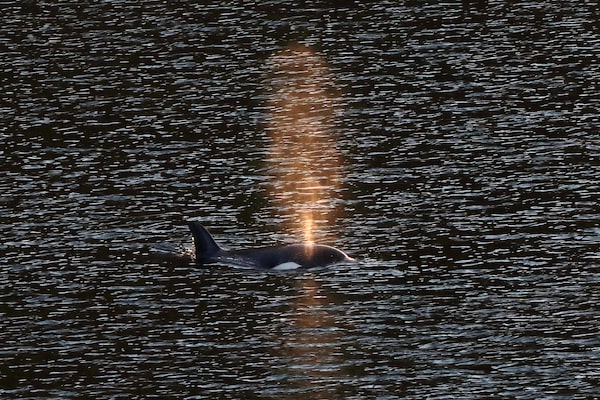
A two-year-old female orca calf swims in Little Espinosa Inlet near Zeballos, B.C., on April 19, about a week before she swam out.Chad Hipolito/The Associated Press
For more than a month, a large team of experts carried out a co-ordinated effort on the northwest coast of Vancouver Island, seeking to free a hungry orphan whale calf trapped in a brackish lagoon. The Bigg’s killer whale, named Brave Little Hunter by the local First Nations, evaded every effort to coax her to freedom, proving to be both smart and stubborn.
But early Friday morning, with just a handful of rescuers watching, she chose her own time to brave a shallow, narrow channel to escape the lagoon. Kwiisahi?is (pronounced Kwee-sa-hay-is) in the local Nuu-chah-nulth language, is finally free.
“At 2:30 a.m. during the high tide on a clear and glass-calm, star-filled night, Kwee-sa-hay-is swam past the sandbar her mother passed away on, under the bridge, down Little Espinosa Inlet and onto Esperanza Inlet all on her own,” Chief Simon John, of the Ehattesaht First Nation, announced in a statement.
The young killer whale was circling her beached mother before swimming out into the lagoon near Zeballos, B.C., on the northwest coast of Vancouver Island on March 23.
The Globe and Mail
The 2½-year-old calf, whose mother, Spong, was beached near the mouth of the lagoon as she hunted a seal, now faces an uncertain future. She is too young, experts believe, to survive on her own, and her best chance will be to join another family of Bigg’s killer whales.
The young whale, also known as T109A3A in the parlance of whale experts who assiduously catalogue every member of this transient whale population off the west coast of North America, comes from a strong family line and there are four clans of her relatives, the T109s, who frequent these waters.
Jennifer Steven of the Whale Centre in Tofino, who has been part of the coastwide effort to track the T109s in hopes of reuniting the calf with her relatives, said Friday that none of the family have been spotted for weeks on the west coast. That doesn’t mean they are out of reach – they could be off hunting in any of the many inlets that carve the coastline, and their communication calls can travel for more than 16 kilometres underwater. But their territory spans from offshore Alaska to California.
Most Bigg’s killer whales share a common dialect, and individuals are known to leave one pod and join another, so experts believe she could easily be adopted into any passing group of her species.
“I’m quite optimistic that that she will connect with, if not her extended family, then another Bigg’s killer whale group,” said John Ford, a leading marine mammal research scientist on the West Coast.
In 2013, Dr. Ford was serving as head of the cetacean research program at Fisheries and Oceans Canada’s Pacific Biological Station when he was involved in a rescue operation involving another young killer whale off of Aristazabal Island, off B.C.’s central coast. That whale, trapped in a bay, was eventually coaxed free and successfully reunited with her family, although she was not in good shape after weeks in isolation. “She was a little emaciated by the time that she got out of the bay, and yet she survived. So based on that, I would say the prospects are pretty good for this whale.”
Although Brave Little Hunter was likely still nursing when her mother died, rescuers watched as she learned to hunt on her own, diving after herring and sea birds. But they supplemented her diet with seal meat – a staple of the Bigg’s killer whale diet – to be certain that she would not waste away while she was trapped.
The effort to keep her alive involved veterinarians, acoustics and drone specialists, heavy equipment operators and data imaging analysts, and vast amounts of equipment from the local community including jet boats, cranes, and massive seine nets. The plans involved coaxing her with recorded messages from her family, and with sea-lion meat, and they attempted to corral her in a bid to physically lift her out of the lagoon and move her to open water. But she evaded all those proven methods.
What drove the extraordinary effort, however, was the determination of the Nuchatlaht and Ehattesaht First Nations to honour their cultural ties to killer whales.
The whale rescue efforts ended exactly as the First Nations community wished – with her peacefully leaving of her own accord. The Ehattesaht nation, based in Zeballos, fronted the cost of this complex rescue effort, recognizing their obligation to these killer whales that feature in their origin stories. Both the Ehattasaht and neighbouring Nuchatlaht were part of the initial efforts to try to save the mother whale, whose loss was grieved through ceremony.
“Ehattesaht and Indigenous people across Canada are writing new stories in these modern times reinforcing the presence of a deep connection between the spirit world, the animal world and the people who have remained on the land and waters for all time,” the Ehattesaht statement said. “Events like these have a deeper meaning and the timing of her departure will be thought about, talked about and felt for generations to come.”